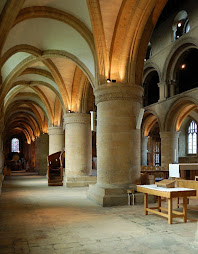 The Great Hall of the National Railway Museum holds train engines from Britain, Japan, and China. Some of the rolling stock hails from the nineteenth century.
The Great Hall of the National Railway Museum holds train engines from Britain, Japan, and China. Some of the rolling stock hails from the nineteenth century.During previous visits to York, I have always been too busy with research to stop in to the National Railway Museum, despite all the good press it receives. Fortunately, one of my stays here finally included a Sunday, which forces me to take a break from church visits (I was raised much too properly to wander the aisles staring upwards and scrutinizing the profiles of vault ribs as a vicar delivers his homily). I decided instead to apply my medieval mind to something much more modern.
Despite the obvious hypocrisy, this art historian find train enthusiasts to be very boring creatures overly concerned about defunct institutions and outdated technology. However, the museum takes care to tell how the history of train travel in Britain, and worldwide, changed leisure, trade, politics, and industry. Railroads opened up all sorts of opportunities and their historical course includes sites for everyone's interests. That and the place is full of huge locomotives that are big, heavy, expensive, powerful, and go faster and faster and faster. I admit I handed control of my afternoon over to childish enthusiasms, but I condoned my glee by reminding myself that I was tech-gawking at rolling stock, not high-powered war machines. Below are some photos. It's a little heavy on boy material (locomotives), but I assure everyone that I did take the time to see the beautifully appointed Royal carriages dating back to Queen Victoria.
 The National Railway museum sits behind York's passenger terminal in what used to be the York Freight Depot Goods Warehouse for the Northeastern Railway Company.
The National Railway museum sits behind York's passenger terminal in what used to be the York Freight Depot Goods Warehouse for the Northeastern Railway Company. The Duchess of Holland was built in 1938 and streamlined with ultra-sleek cladding, but all of its style was removed during World War II. Its shape and colors were only restored this year.
The Duchess of Holland was built in 1938 and streamlined with ultra-sleek cladding, but all of its style was removed during World War II. Its shape and colors were only restored this year. The NRM collection continues to expand. Here in "The Workshop" conservators labor to return the famous Flying Scotsman steam engine to working order.
The NRM collection continues to expand. Here in "The Workshop" conservators labor to return the famous Flying Scotsman steam engine to working order. The Mallard set the current world speed record for a steam-powered train in 1938: 126 mph.
The Mallard set the current world speed record for a steam-powered train in 1938: 126 mph. The electric turntable at the center of the Great Hall helped trains at York station turn around from 1954 until the end of steam service in 1968. The museum holds daily demonstrations.
The electric turntable at the center of the Great Hall helped trains at York station turn around from 1954 until the end of steam service in 1968. The museum holds daily demonstrations.






.jpg)
No comments:
Post a Comment